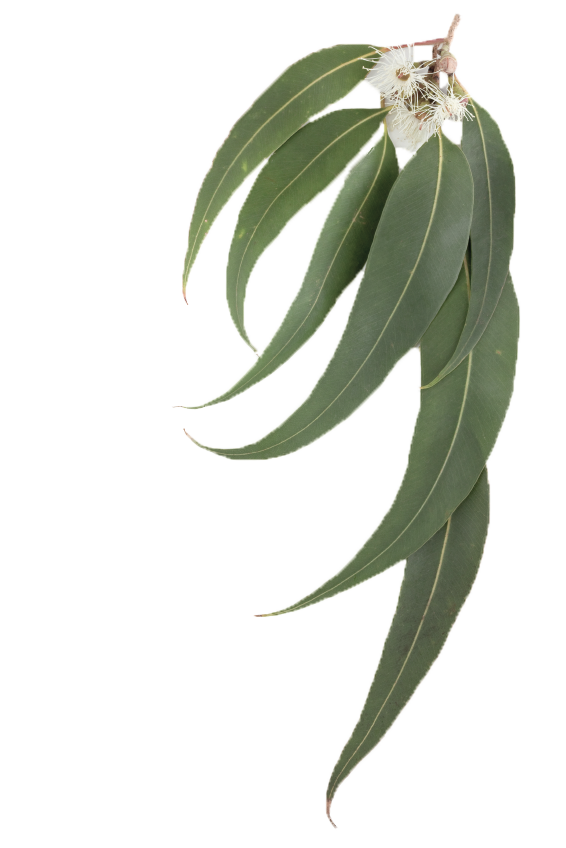Dr Christopher Turbill (SOSC)
 Christopher is an animal physiological ecologist. His research integrates physiology, behaviour and life-history ecology to understand how animals 'solve the problem of survival' and successfully reproduce in the face of natural and human-induced environmental challenges.
Christopher is an animal physiological ecologist. His research integrates physiology, behaviour and life-history ecology to understand how animals 'solve the problem of survival' and successfully reproduce in the face of natural and human-induced environmental challenges.
He is interested particularly in the functional significance of thermoregulatory effects on metabolism – to discover the ecological consequences of variation in body temperature and its links with metabolic energy expenditure, particularly in mammals.
He addresses these questions with detailed lab-based measurements, field-based observational and experimental studies and desk-bound studies of comparative (evolutionary) physiology and life-history ecology.
Prior to joining the HIE, Christopher spent nearly four years as a postdoctoral fellow at The Research Institute for Wildlife Ecology (FIWI) at the Vetmed University in Vienna, Austria. During this time, he worked with Professors Thomas Ruf and Walter Arnold on a large experiment to distinguish how endogenous biorhythms and food availability drive fluctuations in heart rate and rumen temperature (proxies for metabolic energy expenditure) of semi-wild red deer.
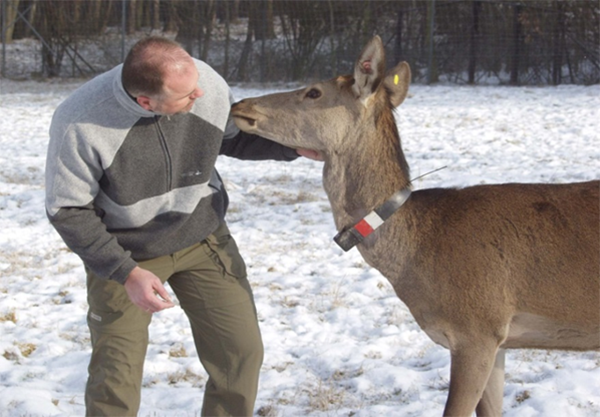
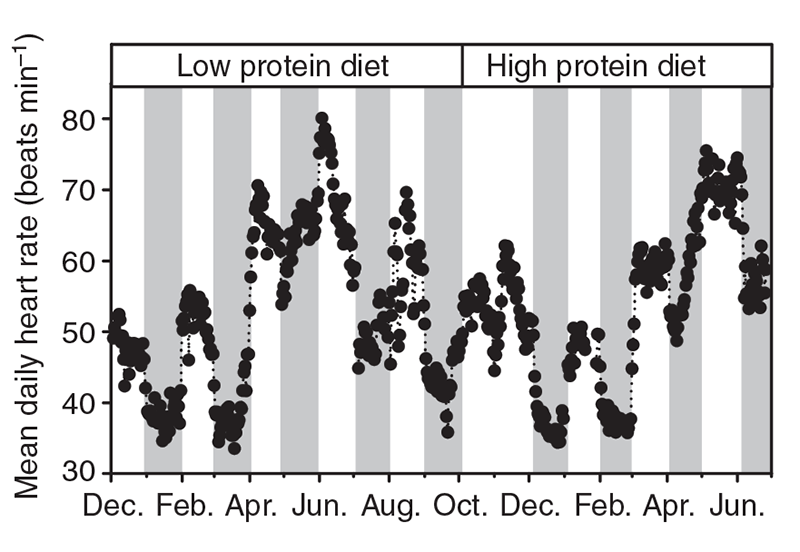
Fig. 1. Heart rate of red deer varies greatly in response to both season and monthly periods of food restriction over the year (see Turbill et al. 2011a)
Other collaborative research projects conducted during his postdoc discovered for example how:
- daily torpor and hibernation increase survival rate and allow the evolution of slow life-histories in hibernators compared to other mammals (Turbill et al. 2011a)
- introduction of a divergent mitochondrial (i.e. maternally inherited) haplotype reduces male fecundity a population of European brown hares – an example of the 'mother's curse effect' (Smith et al. 2010)
- daily torpor and hibernation by hamsters and dormice slow rate of telomere shortening – an index of rate of ageing (Turbill et al. 2012, 2013)
- timing of birth (early versus late season) leads to alternative optimal life-history strategies in hazel dormice (Bieber et al. 2012)
- torpor by juvenile garden dormice allows them to grow and fatten prior to hibernation (Giroud et al. 2012, 2014)
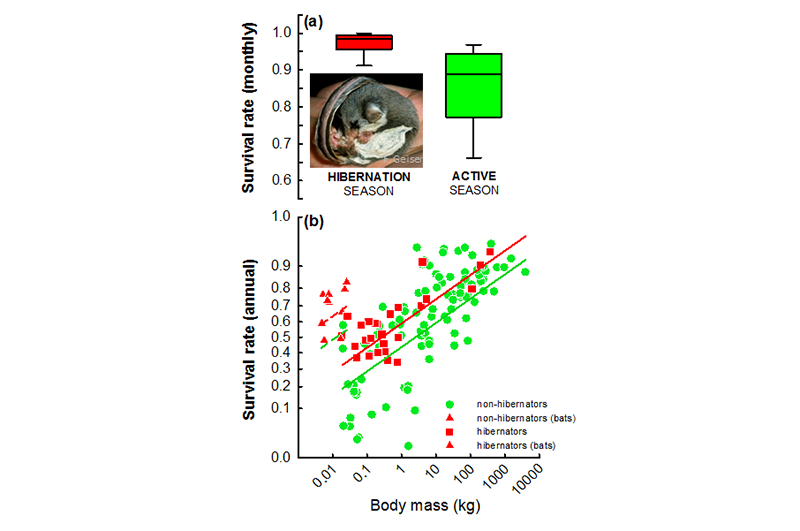
Fig. 2. Hibernation increases survival rates among mammals (see: Turbill et al. 2011b)
Christopher was granted a PhD in October 2006 from the University of New England in Armidale under the excellent supervision of Professor Fritz Geiser. His PhD thesis examined the close linkages between thermoregulatory energetics, activity patterns and micro and macro environmental conditions in several species of tree-roosting microbats.
Prior to his academic career, Christopher was employed on several occasions with government conservation departments. From 2006, he spent two years in a desktop research position with the NSW Scientific Committee (Threatened Species) and prior to 2002 he spent a number of field seasons carrying out vertebrate fauna survey work across northern and western NSW.
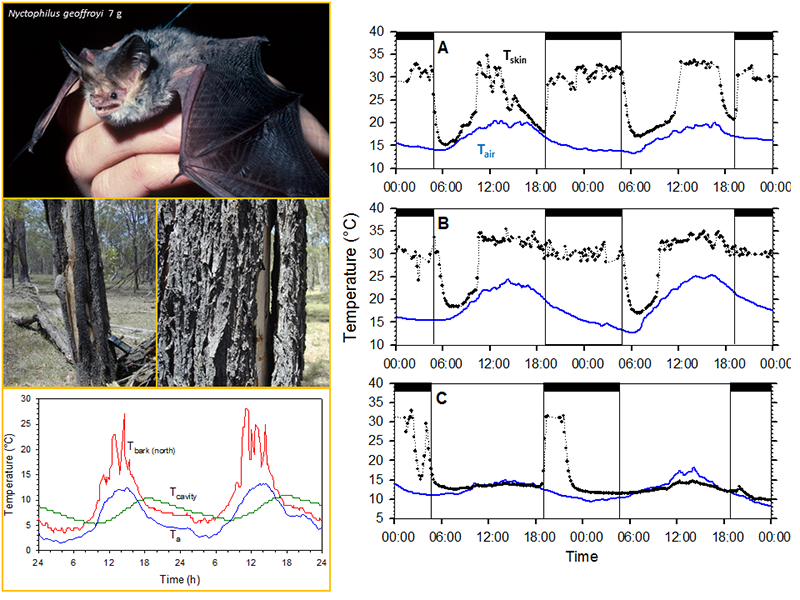
Fig. 3. Australian long-eared bats (Nyctophilus geoffroyi) typically roost under bark on the northern side of trees, where they receive significant amounts of passive warming from external air and solar radiation (see graph on left). During roosting in summer, N. geoffroyi employ torpor every day, either in the morning and afternoon (A; most days), only in the morning (B; warmest days) or during part of the night and the whole daytime (C; coldest days; see Turbill et al. 2003)
A current focus in Turbill's research group is the integration of thermoregulatory physiology with hypotheses describing the functional significance of variation in resting metabolic rate among populations of animals, particularly mammals.
This research is critical to understanding how animals cope with natural and human-induced environmental challenges. His research group is addressing this knowledge gap by three general avenues of study:
- field studies to measure the thermoregulatory behaviour and metabolic energy expenditure of wild animals experiencing natural and human-indicued variability in environmental conditions
- experiments to quanitify effects of manipulation of key environmental variables (e.g. predation risk, food availability) on the behaviour, thermal energetics and fitness of individuals using semi-natural foraging and field enclosures
- measurements in the lab of behavioural, metabolic and other physiological responses and capabilities of animals under carefully controlled environmental conditions
- Physiological ecology of animals, particularly thermoregulation, metabolism and energetics
- Dormancy, particularly torpor and hibernation by mammals and birds
- Life-history ecology: evolution of optimal life-history strategies
- Integrative ecology: linking behaviour, physiology and life-histories to test the hypothesis that individual take different integrated 'syndromes' to cope with environmental challenges
- Chiroptera (bats): thermal and metabolic physiology; ecology and conservation
- Telomeres as a biomarker of physiological costs and ageing
Dr Chris Turbill has secured a number of high-profile grants including a prestigious ARC Discovery Early Career Researcher Award (DECRA) and contributes strongly to the animal ecology field at the Institute:
Oxidative stress as a physiological constraint on the pace of life histories
Partner/Funding Body: Western Sydney University, Australian Research Council (ACRG)
Period: 2012-2015
Energetic consequences of antipredator behaviour in small mammal prey
Partner/Funding Body: Hermon Slade Foundation Period: 2012-2015
Telomere dynamics as an index of biological aging
Partner/Funding Body: University of Veterinary Medicine Vienna 'Start-up Project'
Period: 2010
Food availability as a cue for physiological mechanisms of winter energy conservation by red deer
Partner/Funding Body: Austrian Science Fund (FWF) 'Stand-alone Project
Period: 2008-11
Barratt AE, Gonsalves L, Turbill C, (2023) 'Winter torpor and activity patterns of a fishing bat (Myotis macropus) in a mild climate', Journal of Mammalogy, vol.104, no.1, pp 76-85
Lownds RM, Turbill C, White TE, Umbers KD, (2023) 'The impact of elevated aestivation temperatures on the behaviour of bogong moths (Agrotis infusa)', Journal of Thermal Biology, vol.113, Article no.103538
Madani G, Turbill C, Law B, (2023) 'The golden tip for better breeding: evidence for polyoestry in the golden-tipped bat (Phoniscus papuensis)', Australian Mammalogy, vol.45, no.3, pp 369-374
Hanrahan N, Dalziell AH, Turbill C, Armstrong KN, Welbergen JA, (2022) 'Ethogram of ghost bat (Macroderma gigas) behaviours and associated social vocalisations', Acta Chiropterologica, vol.24, no.1, pp 195-208
Madani G, Turbill C, Lloyd A, Gonsalves L, Brassil T, Law B, (2022) 'How do we sleep while our beds are burning? Impacts of the 2019-20 mega-fires on a rainforest dependent species – the Golden-tipped Bat Phoniscus papuensis', Australian Zoologist, vol.42, no.1, pp 223-242
Nowack J, Turbill C, (2022) 'Survivable hypothermia or torpor in a wild-living rat: rare insights broaden our understanding of endothermic physiology', Journal of Comparative Physiology B, vol.192, pp 183–192
Yabsley SH, Meade J, Hibburt TD, Martin JM, Boardman WSJ, Nicolle D, Walker MJ, Turbill C, Welbergen JA, (2022) 'Variety is the spice of life: Flying-foxes exploit a variety of native and exotic food plants in an urban landscape mosaic', Frontiers in Ecology and Evolution, vol.10, Article no.907966
Turbill C, Welbergen JA, (2020) 'Anticipating white-nose syndrome in the Southern Hemisphere: Widespread conditions favourable to Pseudogymnoascus destructans pose a serious risk to Australia's bat fauna', Austral Ecology, vol.45, no.1, pp 89-96
Romano AB, Hunt A, Welbergen JA, Turbill C, (2019) 'Nocturnal torpor by superb fairy-wrens: A key mechanism for reducing winter daily energy expenditure', Biology Letters, vol.15, no.6, Article no. 20190211
Turbill C, McAllan BM, Prior S, (2019) 'Thermal energetics and behaviour of a small, insectivorous marsupial in response to the interacting risks of starvation and predation', Oecologia, vol.191, no.4, pp 803-815
Turbill C, Stojanovski L, (2019) 'Torpor reduces predation risk by compensating for the energetic cost of antipredator foraging behaviours', Proceedings of the Royal Society B-Biological Science, vol.285, no.1893, Article no.20182370
Bieber C, Turbill C, Ruf T, (2018) 'Effects of aging on timing of hibernation and reproduction', Scientific Reports, vol.8, no.1, Article no.13881
Turbill C, Stojanovski L, (2018) 'Torpor reduces predation risk by compensating for the energetic cost of antipredator foraging behaviours', Proceedings of the Royal Society B: Biological Sciences, vol.285, no.1893, Article no.20182370
Turbill C, Prior S, (2016) 'Thermal climate-linked variation in annual survival rate of hibernating rodents: shorter winter dormancy and lower survival in warmer climates', Functional Ecology, vol.30, no.8, pp 1366-1372
Giroud S, Zahn S, Criscuolo F, Chery I, Blanc S, Turbill C, Ruf T, (2014) 'Late-born intermittently fasted juvenile garden dormice use torpor to grow and fatten prior to hibernation: Consequences for ageing processes' (opens in a new window), Proceedings of the Royal Society B: Biological Sciences, vol.281, no.1797, pp 1-9
Nussey DH, Baird D, Barrett E, Boner W, Fairlie J, Gemmell N, Hartmann N, Horn T, Haussmann M, Olsson M, Turbill C, Verhulst S, Zahn S, Monaghan P, (2014) 'Measuring telomere length and telomere dynamics in evolutionary biology and ecology' (opens in a new window), Methods in Ecology and Evolution, vol.5, no.4, pp 299-310
Turbill C, Ruf T, Rothmann A, Arnold W, (2013) 'Social Dominance Is Associated with Individual Differences in Heart Rate and Energetic Response to Food Restriction in Female Red Deer' (opens in a new window), Physiological and Biochemical Zoology, vol.86, no.5, pp 528-537
Turbill C, Ruf T, Smith S, Bieber C, (2013) 'Seasonal variation in telomere length of a hibernating rodent' (opens in a new window), Biology Letters, vol.9, no.2, Article no.1095
Bieber C, Juskaitis R, Turbill C, Ruf T, (2012) 'High survival during hibernation affects onset and timing of reproduction' (opens in a new window), Oecologia, vol.169, no.1, pp 155-166
Turbill C, Smith S, Deimel C, Ruf T, (2012) 'Daily torpor is associated with telomere length change over winter in Djungarian hamsters' (opens in a new window), Biology Letters, vol.8, no.2, pp 304-307
Turbill C, Bieber C, Ruf T, (2011) 'Seasonal dormancy increases survival and is associated with the evolution of slow life histories in hibernating mammals', Proceedings of the Royal Society B: Biological Sciences, Published online: 30.03.2011. (Editor's Choice, Science 332: p.284)
Smith C, Turbill C, Penn D, (2011) 'Chasing telomeres not red herrings in evolutionary ecology' (opens in a new window), Heredity, Published online: 16.03.2011.
Turbill C, Ruf T, Mang T, Arnold W, (2011) 'Regulation of heart rate and rumen temperature in red deer: effects of season and food intake' (opens in a new window), The Journal of Experimental Biology, vol.214, pp 963-970
Turbill C, Ruf T, (2010) 'Senescence is more important in the natural lives of long- than short-lived mammal species' (opens in a new window), PLoS ONE, vol.5, no.8, article no e12019
Smith S, Turbill C, Suchentrunk F, (2010) 'Introducing mother's curse: low male fertility associated with an imported mtDNA haplotype in a captive colony of brown hares' (opens in a new window), Molecular Ecology, vol.19, pp 36-47
Geiser F, Turbill C,(2009) 'Hibernation and daily torpor minimize mammalian extinctions' (opens in a new window), Naturwissenschaften, vol.96, pp 1235-1240
Stawski C, Turbill C, Geiser F, (2009) 'Hibernation by a free-ranging subtropical bat (Nyctophilus bifax)' (opens in a new window), Journal of Comparative Physiology B, vol.179, pp 433-441
Turbill C, Körtner G, Geiser F, (2008) 'Timing of the daily temperature cycle affects the critical arousal temperature and energy expenditure of lesser long-eared bats' (opens in a new window), The Journal of Experimental Biology, vol.211, pp 3871-3878
Turbill C, (2008) 'Winter activity of Australian tree-roosting bats: influence of temperature and climatic patterns' (opens in a new window), Journal of Zoology, London, vol.276, pp 285-290
Turbill C, Geiser F, (2008) 'Hibernation by tree-roosting bats' (opens in a new window), Journal of Comparative Physiology B, vol.178, pp 597-605
Turbill C, Geiser F, (2006) 'Thermal physiology of pregnant and lactating female and male long-eared bats, Nyctophilus geoffroyi and N. gouldi', Journal of Comparative Physiology B, vol.176, pp 165-172
Turbill C, Körtner G, Geiser F, (2003) 'Natural use of heterothermy by a small tree-roosting bat during summer', Physiological and Biochemical Zoology, vol.76, pp 868-876
Turbill C, Law BS,Geiser F, (2003) 'Summer torpor in a free-ranging bat from sub-tropical Australia', Journal of Thermal Biology, vol.28, pp 223-226
Graduated students at postgraduate level include:
- Elle McDonald
- Lisa Stojanovski
- Lisa Bromfield
- Nicholas Colman
- Ben Feit



